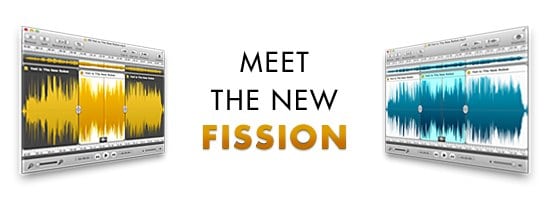Fission is a simple audio editing program for Mac which has been around for a while now. True to its billing as the fast and lossless audio editor, this tool comes in handy for manipulating digital audio files, whether you need to splice tracks, create ringtones, trim audio songs, edit recorded files, fade tracks in or out etc. Once you get the handle of this tool, you can do any of these aforementioned tasks and more.
Whether you’re creating a podcast, making a movie, or just joining two MP3 files together, at some point of time you’ll have to edit an audio file. Although audio software for Mac such as GarageBand can deal with such tasks, Fission, developed by popular Mac developer Rogue Amoeba, can handle all these audio-related tasks more easily.
What’s new? The Fission Review
As with the original, when you edit audio files in Fission 2, their original format is retained; certain audio editing programs for Mac convert files to an output format say AIFF and then convert them back to their source format. This is where Fission scores. This approach not only saves a lot of time but also makes editing far easier, as you can edit MP3 or AAC files without actually having to go back and forth between formats. While the basics of the original version haven’t changed, the upgraded version has got a different feel to it thanks to the all new interface. The help system has improved a lot, as well, with more illustrations and screenshots to walk you through the tasks you’re most likely to do next. The performance also seems to be more effective and snappier.
Packed with a lot of useful features, the latest version also allows you to open multiple windows at a time, which is a welcome addition. It was a bit of a hassle to have only one window open at a time, especially in instances in which you wanted to copy and paste parts of audio from one file to another.
Working with it
The very first thing you see when you load an audio file on Fission is the waveform of the audio. As with any other audio editing software, you can then easily pick parts to remove, split your audio recording into different fragments (to create markers for say a podcast), crop a chunk of audio from a selected portion, or normalize a segment or the entirety of your audio file.
You can zoom into the waveform displayed on the central interface by moving a slider or using a simple keyboard shortcut to make precise editing. The Inspector feature allows you to add general metadata to your audio file, add notes and tags. What’s more, you can also drag in various sound files into your recording over a particular split point you’ve created already.
Powerful though this app is, we have a couple of niggles. It doesn’t have the ability to record audio files from within the app and doesn’t allow you to start work with a blank file.
The bottom-line
There’s certainly a lot to like about this version of Fission- it gives you the great power of precise editing in a simple and clean interface. Perhaps a few more options, features and hacks would make it the grand daddy of audio editing. Check out Fission 2.0 if you have not already.
 Gearfuse Technology, Science, Culture & More
Gearfuse Technology, Science, Culture & More



